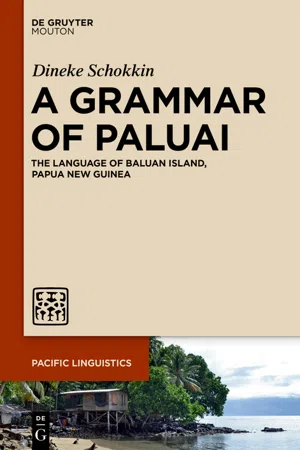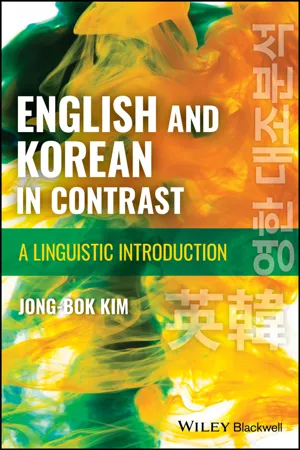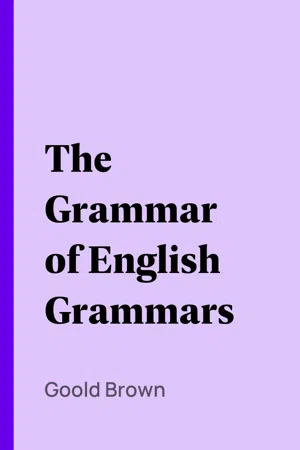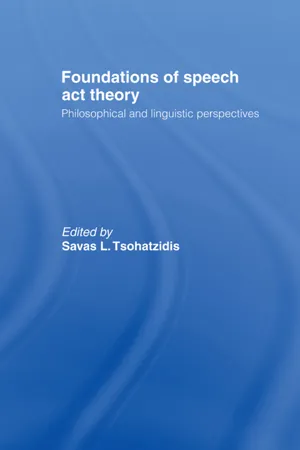Languages & Linguistics
Interrogative Mood
The interrogative mood is a grammatical mood used to form questions. It is characterized by the use of an auxiliary verb before the subject of the sentence. In English, the auxiliary verb "do" is often used to form questions in the interrogative mood.
Written by Perlego with AI-assistance
Related key terms
Related key terms
1 of 4
Related key terms
1 of 3
4 Key excerpts on "Interrogative Mood"
- eBook - ePub
A Grammar of Paluai
The Language of Baluan Island, Papua New Guinea
- Dineke Schokkin(Author)
- 2020(Publication Date)
- De Gruyter Mouton(Publisher)
10 Speech act distinctions and polarityThe two categories discussed in this chapter, mood and polarity, relate at the same time to the VC and to a higher level of organisation such as the clause or the sentence. Mood is defined as the grammatical expression of illocutionary force; polarity refers to the positive or negative value of a proposition.10.1 Mood
Three moods can be distinguished: declarative, imperative and interrogative. Each type of mood is most prototypically connected to one type of speech act or illocutionary function: declarative mood is normally used for statements, imperative mood for commands, and Interrogative Mood for questions. Paluai does not have morphological marking for any of these, nor is mood distinguished by grammatical means such as constituent order. Mood is mainly indicated by means of prosody, with different intonation patterns for a question or a statement (see Section 2.3.2.1). In addition, grammatical criteria for declarative and imperative clauses are slightly different, and content questions can be recognised by the presence of a question word. In what follows, features of declarative, interrogative and imperative sentences will be discussed, with special attention to the use of the interrogative and the imperative moods. Differences between the latter two and the declarative mood, which can be considered the unmarked or default option, will be highlighted.10.1.1 Interrogative Mood
Interrogative Mood applies to the speech act “question”, which is most typically an information-seeking speech act. Three types of questions can be distinguished: content questions, polar questions and tag questions. These will be discussed in turn.10.1.1.1 Content questions
Content questions contain an interrogative word and make inquiries about a particular object or proposition (see Section 4.7 for an overview of interrogative words and what type of element they query). The interrogative word remains in situ: its syntactic slot is exactly that of the queried constituent in the question’s declarative counterpart. Content questions are thus recognisable by the presence of an interrogative word, and also by a specific intonation contour that differs from the one associated with declarative statements. The focused element of a question receives phrasal stress. The question ‘What are you doing?’ can be realised in two ways (with the stressed element printed in bold): - eBook - ePub
English and Korean in Contrast
A Linguistic Introduction
- Jong-Bok Kim(Author)
- 2024(Publication Date)
- Wiley-Blackwell(Publisher)
9 Interrogative Constructions: Asking a Question9.1 Clausal Types and Interrogatives
As noted in Chapter 6 , languages have a set of clause types characteristically used to indicate different speech acts or moods. Consider the following examples in English:- (1)
- Declarative: John is clever.
- Interrogative: Is John clever? Who is clever?
- Exclamative: How clever you are!
- Imperative: Be very clever.
Each sentence form here has its own typical function to represent a speech act. For example, the declarative makes a statement, the interrogative asks a question, the exclamative represents an exclamatory statement, and the imperative issues a directive. However, these correspondences are not always one‐to‐one. For example, the declarative in (2a) represents not a statement but a question, and the interrogative in (2b) indicates a directive:- (2)
- I ask you if this is what you want.
- Would you mind taking out the garbage?
- (3)
- Declarative
사과를 먹었다. sakwa‐lul mek‐ess‐ta apple‐ACC eat‐PST ‐DECL ‘(He) ate an apple.’ - Interrogative
사과를 먹었니? sakwa‐lul mek‐ees‐ni? apple‐ACC eat‐PST ‐QUE ‘Did you eat the apple?’ - Imperative
사과를 먹어라! sakwa‐lul mek‐ela! apple‐ACC eat‐IMP ‘Eat an apple!’ - Exclamative
사과를 맛있게 먹는구나! sakwa‐lul masisskey mek‐nun‐kwuna apple‐ACC deliciously eat‐PRES ‐EXCL ‘(lit.) How deliciously you are eating the apple!’
- Declarative
The declarative, interrogative, imperative, and suggestive here is marked by the final verbal suffix, and linked to a typical speech act. That is, (3a) makes a statement, (3b) asks a question, (3c) gives a command, and (3d) makes a suggestion. Similar to English, this general mapping relation can be overridden: - eBook - ePub
- Goold Brown(Author)
- 2004(Publication Date)
- Perlego(Publisher)
Subjunctive Mood. But here again it is better to refer still to the Indicative or Potential mood whatsoever has any proper sign of such mood, even though it occur in a dependent clause.OBS. 3.—The Potential mood is so called because the leading idea expressed by it, is that of the power of performing some action. This mood is known by the signs may, can, must, might, could, would, and should. Some of these auxiliaries convey other ideas than that of power in the agent; but there is no occasion to explain them severally here. The potential mood, like the indicative, may be used in asking a question; as, "Must I budge? must I observe you? must I stand and crouch under your testy humour?"—Shakspeare. No question can be asked in any other mood than these two. By some grammarians, the potential mood has been included in the subjunctive, because its meaning is often expressed in Latin by what in that language is called the subjunctive. By others, it has been entirely rejected, because all its tenses are compound, and it has been thought the words could as well be parsed separately. Neither of these opinions is sufficiently prevalent, or sufficiently plausible, to deserve a laboured refutation. On the other hand, James White, in his Essay on the English Verb, (London, 1761,) divided this mood into the following five: "the Elective," denoted by may or might; "the Potential," by can or could; "the Determinative" by would; "the Obligative," by should; and "the Compulsive," by must. Such a distribution is needlessly minute. Most of these can as well be spared as those other "moods, Interrogative, Optative, Promissive, Hortative, Precative, &c.", which Murray mentions only to reject. See his Octavo Gram. - eBook - ePub
Foundations of Speech Act Theory
Philosophical and Linguistic Perspectives
- S.L. Tsohatzidis, S.L. Tsohatzidis(Authors)
- 2002(Publication Date)
- Routledge(Publisher)
Two classes of sentences tend to stand apart from others by virtue of their modality. The first class comprises imperative sentences, which do not make statements at all, but express commands or instructions … Interrogative sentences also stand in contrast to declarative sentences … they may be characterized by additional modalities which indicate the expectations of the speaker. (ibid.: 303–4) However, in a more recent work (1977) he retracts his earlier usage, It [mood] cannot be identified with either modality or illocutionary force as such … In traditional usage, ‘mood’ is applied to such subsets of inflected forms of verbs as are distinguished one from another by means of the terms ‘indicative’, ‘imperative’, ‘subjunctive’, etc.; and we have chosen to respect this usage. (ibid.: 848) Lyons does not say what role the verbal notion of mood plays in the theory of language. 2 On the other hand, we will see exactly what role the sentential conception will play. We will follow the tradition of treating mood as a mixed concept by treating it as a form-with-a-function. There is also the compromise position; mood is a verbal inflection indicating the use of the sentence. For instance, Bybee (1985) writes, 3 mood is a marker on the verb that signals … what the speaker is doing with the proposition … the verb inflection signals a speech act type -something the speaker is doing with the whole proposition. (ibid.: 105–6) More recently, in the Jespersen tradition, Sadock and Zwicky (1985) characterize a mood (they call it a ‘sentence type’) in two ways: 1 Within a language: a mood is ‘a coincidence of grammatical structure and conventional (conventionally indicated) conversational use’ (Sadock and Zwicky 1985: 155). A ‘regular association of form and speaker’s use of sentences’ (ibid.: 156)
Index pages curate the most relevant extracts from our library of academic textbooks. They’ve been created using an in-house natural language model (NLM), each adding context and meaning to key research topics.
Explore more topic indexes
Explore more topic indexes
1 of 6
Explore more topic indexes
1 of 4



